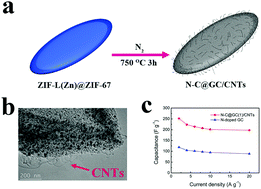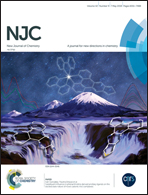N-Doped hierarchically porous carbon derived from heterogeneous core–shell ZIF-L(Zn)@ZIF-67 for supercapacitor application†
Abstract
Heterogeneous core–shell ZIF-L(Zn)@ZIF-67 nanoleaves are controllably synthesized in aqueous media at room temperature in the light of our previously reported strategy. After direct carbonization under a nitrogen atmosphere, hierarchically porous amorphous carbon@graphite carbon core–shell nanoleaves with high nitrogen-doping content and carbon nanotubes (N-C@GC/CNTs) are obtained. The morphology, microstructure and the evolution process of N-C@GC/CNTs are systematically investigated by scanning electron microscopy, transmission electron microscopy, adsorption/desorption isotherms etc. All obtained N-C@GC/CNTs are employed to construct supercapacitors, and the results indicate that the optimized N-C@GC/CNTs exhibit a distinguished capacitance (252.1 F g−1) and excellent stability (about 91.2% capacitance retention after 10 000 cycles) as supercapacitor electrodes due to their hierarchical pore structure, high nitrogen content and superior electrical conductivity resulting from graphitic structure and carbon nanotubes. This work not only extends our previously proposed strategy to synthesize heterogeneous core–shell of zeolitic imidazolate frameworks, but also provides a new avenue for preparing novel core–shell N-C@GC/CNTs with superior electrochemical performance.



 Please wait while we load your content...
Please wait while we load your content...